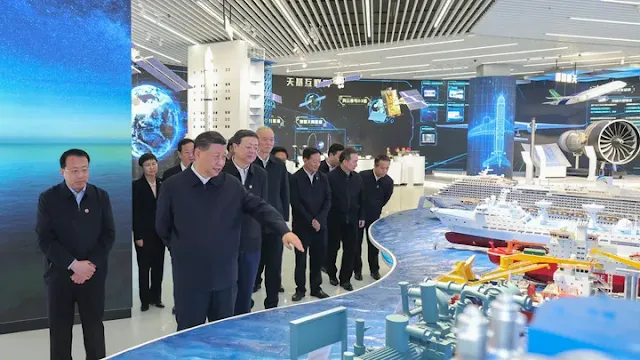The U.S. Department of Defense has
issued a warning regarding the extensive integration of China's artificial
intelligence (AI) initiatives with the People's Liberation Army (PLA). This has
sparked concerns about a potential AI arms race.
James Anderson, who previously
served as the deputy undersecretary of defense during the Trump administration,
expressed astonishment at the size, scope, and sophistication of Chinese
military modernization programs. He conveyed to Fox News Digital, the report
clearly indicates that Beijing is steadfast in its pursuit of building a
world-class military force, despite the recent economic slowdown.
In the annual Pentagon report on Military and Security Developments involving the People's Republic of China, the preface argues that China remains the foremost challenge for the Department of Defense. Beijing's aim of achieving "national rejuvenation" by 2049, the centenary anniversary of the Chinese Communist Party (CCP), underscores the significance of this concern.
At the forefront of the strategies
pursued by the party to attain its objectives is the "multi-domain precision warfare" concept. This concept aims to
leverage advancements in big data and artificial intelligence (AI) to swiftly
identify critical vulnerabilities within the U.S. operational system.
Subsequently, it involves orchestrating joint forces across different domains
for precise strikes, as outlined in the report.
This approach is anticipated to
facilitate the creation of "additional
subordinate operational concepts," enhancing China's capabilities to
effectively engage and triumph in "future
wars." The latest Five-Year Plan of the country prioritizes these
advancements, with a focus on areas such as "brain science" and biotechnology, semiconductors, as well as
technologies related to deep space, deep sea, and polar exploration, as
asserted by the Pentagon.
The field of brain science is
aiming to integrate novel biotechnological and AI applications. This includes
the allocation of funds exceeding a billion dollars for a national quantum
facility, envisioned to be the world's largest upon completion. This facility
is expected to house a quantum computer capable of "outperforming a classical high-performance computer for a specific
problem."
The report emphasizes that Beijing is well aware of its remaining deficiencies in science and technology (S&T). To bridge these gaps, China employs industrial policies and utilizes its extensive technology transfer apparatus. The country maintains substantial research and development (R&D) funding levels, coupled with significant subsidies for domestic companies engaged in pioneering technologies.
 |
| Chinese President Xi Jinping inspects an exhibition on Shanghai's sci-tech innovations in Shanghai |
The report also outlines China's
ambition to lead global AI development by 2030, recognizing the technology as
crucial for "intelligentized warfare,"
aligning with the Chinese Communist Party's perspective on the future of
combat. While acknowledging China's current leadership in facial recognition
and natural language processing technology, the Pentagon remains "silent" on "certain foreign capabilities,"
especially in the production of hardware, including advanced semiconductor chip
factories and electronic design automation software.
According to Matt McInnis, a senior
fellow for the Institute for the Study of War's China program, China aims to
not only catch up with but surpass the United States in the field of artificial
intelligence (AI) by the year 2025. He cautioned that the United States is at
risk of lagging behind China in AI, particularly in the integration of AI into
warfighting systems.
Despite this, McInnis remains
optimistic about the United States maintaining its leading position in AI,
citing the nation's substantial resources and potential. He pointed out that
the U.S. benefits from a more open and competitive environment for AI
development. Additionally, he suggested that an advantage may lie in adopting a
more deliberate and cautious approach to deploying AI in warfare.
McInnis emphasized China's intense focus on AI and other advanced technologies to surpass the U.S. military, often at the expense of necessary training, doctrine, and personnel development within the People's Liberation Army (PLA). He cautioned that AI alone is not a cure-all for the PLA's weaknesses. Success for the U.S., according to McInnis, involves identifying vulnerabilities created by China's potential over-reliance on AI.
The Pentagon's report provided
diverse assessments of China's current capabilities; however, Anderson
cautioned about the broadly "opaque
nature" of China's systems, making it challenging to fully comprehend
the extent of the country's AI technology development.
Despite the U.S. holding advantages
in AI-related technologies, Anderson stressed that this should not be a source
of comfort, as these advantages seem to be diminishing in comparison to Chinese
advancements. He emphasized that China is unequivocally striving to become the
global leader in AI by the end of the decade, committing substantial resources
to achieve this objective.
 |
| Soldiers quickly get out of their cars to take up positions during military drills in Jiangxi, China |
Anderson pointed out that AI
technologies will enhance the speed and lethality of new military platforms and
rejuvenate older ones. Anticipating the proliferation of air, sea, land, and
space-based unmanned platforms driven by AI in the coming years, he highlighted
their pivotal role in any major military confrontation between the U.S. and
China.
Anderson emphasized the critical importance of deploying AI-related technologies on a large scale. Last summer, the Pentagon unveiled the Replicator Initiative, aiming to manufacture and deploy thousands of AI-guided drones in the Indo-Pacific. However, there are doubts about the Pentagon's ability to carry out this initiative, given the compromised state of America's Defense Industrial Base.
Beyond AI capabilities, the report
underscored the alarming pace at which China has advanced its nuclear arsenal,
intending to rival U.S. and Russian capabilities and thereby creating a
tripolar global dynamic. Both McInnis and Anderson expressed significant
concerns about China's nuclear developments, with McInnis deeming them
"concerning," and Anderson describing the trajectory as "alarming."
Anderson highlighted the strategic
implications of this nuclear development, emphasizing that in just a few years,
the United States will face the unprecedented challenge of deterring two
nuclear peers, Russia and China, simultaneously.


0 Comments